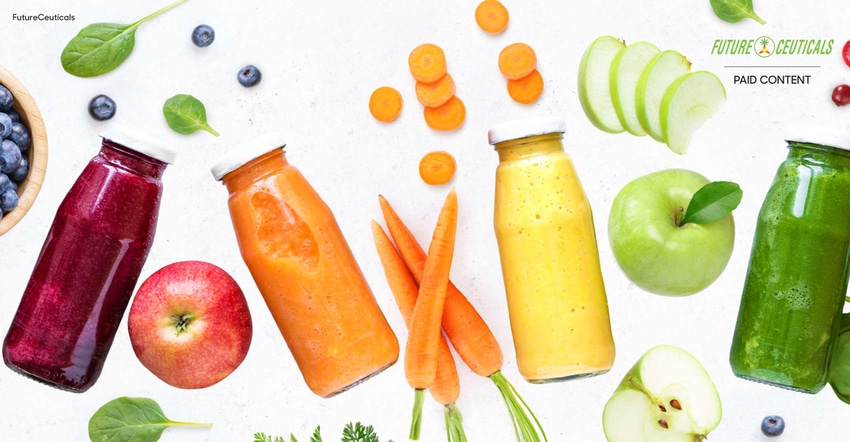NatureKnit provides fiber-bound polyphenols for optimal gut health – article
Getting enough fiber in their diet is a key concern for many Americans. Futureceuticals’ NatureKnit™ makes adding fiber affordable, convenient and accessible.
December 2, 2022

Sponsored by FutureCeuticals
Approximately ninety-five percent of Americans do not consume enough dietary fiber, according to the most recent Dietary Guidelines for Americans. It is one of four dietary components the FDA classifies as a public health concern. Americans simply do not eat enough fiber-packed fruits, vegetables and whole grains.
“As much as we encourage people to eat whole foods—the majority of dietary patterns in America are still far too high in processed foods,” says Brendan Kesler, R&D Innovation Director at Van Drunen Farms and FutureCeuticals. To help solve America’s fiber crisis, “the nutrition industry needs to create products that make dietary fiber convenient, affordable and accessible to consumers,” he says.
FutureCeuticals empowers brands to do exactly that with NatureKnitTM. Made from real foods including carrot, blueberry, cranberry, apple and spinach, NatureKnit delivers true, intact dietary fiber and polyphenols, naturally bound together. “Dietary fiber and bound-polyphenols work synergistically to reach the gut, where they promote unique benefits in the gut and beyond,” Kesler adds.
Steady, growing demand for fiber
The global dietary fibers market size was valued at $7,900 million in 2020, and is projected to reach $21,672.9 million by 2030, registering a CAGR of 11.1%, according to Allied Market Research. Consumer interest in dietary fiber has surged as research has shown that we are significantly under consuming fiber, and that fiber is linked to promotion of many health benefits in the gut and throughout the body. In the United States, the gastrointestinal health category (closely associated with fiber) jumped by 6.5% from $2,990 million in sales in 2019 to $3,184 million in 2020, according to Nutrition Business Journal’s (NBJ) 2022 Condition Specific Report. Sales grew by 8.7% in 2021 to reach $3,461 million. Researchers estimate growth will slow to 4.8% in 2022 for sales of $3,629 million. They forecast 5.1% growth for 2023. Nearly half the consumers who responded to a recent NBJ survey said they are currently and actively trying to optimize their gut/digestive health.
Enormous opportunity
“Fiber may be the biggest gap in nutrition that the supplement industry is doing the least to address,” write NBJ analysts in the 2022 Microbiome Report. They call this out again in the NBJ Condition Specific Report: “Fiber is undersold, or at least wrongly sold. Too much emphasis on the regular bowel movements steers the discussion away from all the other benefits including cholesterol support and weight management. It’s time to help consumers look past the poop.”
“There is much more to talk about here, including blood sugar and cholesterol, two areas of focus that consumers are very much talking about,” write NBJ analysts. When NBJ survey respondents were asked whether gut health affects other systems in the body, only little more than half said “yes.” Thirty percent said, “I don’t know,” and 15% said “no.”
The survey reveals how much white space for consumer education remains in matters of the microbiome. Remember, write NBJ analysts, that “not much more than 20 years ago, few Americans had heard of probiotics, and now they are a $1.64 billion supplement category and consumed in everything from yogurt shots to potato chips. All that took was a simple message of ‘good bugs do good stuff.’”
Dietary fiber and polyphenols
One of the leading theories explaining fiber’s role in health beyond the gut involves polyphenols, explains Kesler. The discovery that true dietary fiber from nature is a major carrier of bound polyphenols brings an exciting new element into the fiber conversation. Polyphenols are the most abundant antioxidants found in our diet, making up about 90% of dietary antioxidant intake. Epidemiological studies (like those around the Mediterranean Diet) have solidly established their health-promoting benefits. “The fact that fiber is a major carrier of bound polyphenols means that the fiber gap we see may also lead to low antoxidant consumption,” says Kesler, adding, “and, the enormous fiber gap we see in the U.S. may also lead to a very significant antioxidant gap.”
Fiber and polyphenols work together synergistically to promote health throughout the body. Working together, they are able to withstand stomach acid and reach the colon primarily intact. There, they provide fermentable substrates to the microbiome. They promote a localized antioxidant environment, increased fermentation activity, and sustained release of polyphenols. And, they produce beneficial metabolites that can have benefits far beyond the gut.
The NatureKnitTM difference
Unlike many isolated supplemental fibers on the market, NatureKnitTM delivers true dietary fiber exactly as nature creates it, with fiber and bound polyphenols together in the gut where they can begin to impart their benefits throughout the body. The fruit and vegetable fibers found in NatureKnit™ are also natural sources of prebiotics.
“NatureKnitTM is fiber exactly as nature makes it,” says Kesler. FutureCeuticals manufactures the ingredient from upcycled fruits and vegetables, something consumers love. In fact, NatureKnit is now Upcycled Certified™, a third-party certification to highlight upcycled ingredients that help reduce food waste. Consumers like the idea: sixty-one percent of global consumers say they find the concept of upcycled ingredients appealing[1], and eighty-one percent of global consumers say it is important to avoid food waste[2].
The ingredient contains 50% intact dietary fiber, including both soluble and insoluble fiber, which makes it a gentle form of fiber with a pleasant taste. Key applications include ready-to-mix beverages, nutritional supplements, functional bars, wellness smoothies and meal replacements. “It’s an opportunity for brands to help solve America’s fiber gap with convenient formats that Americans with busy lifestyles demand,” Kesler says.
Resources:
[1] FMCG Gurus. “Addressing Food Waste in 2022 and Beyond.” March 23, 2022. https://fmcggurus.com/blog/fmcg-gurus-addressing-food-waste-in-2022-and-beyond/
[2] FMCG Gurus, “The Future of Food Upcycling in 2022.” August 2, 2022. https://fmcggurus.com/blog/fmcg-gurus-the-future-of-food-upcycling-in-2022/
You May Also Like




.png?width=800&auto=webp&quality=80&disable=upscale)